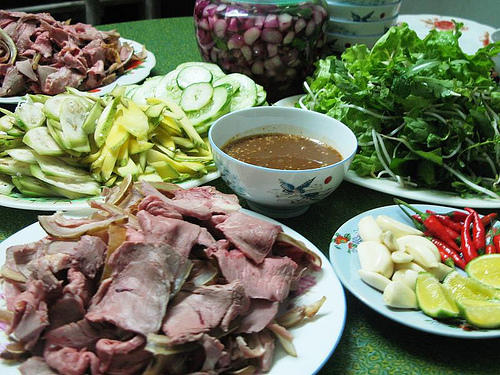This is a specialty dish of Quang for half a century now, the pride of the people of a small village located in the north of Cau Lau bridge – the bridge over the Thu Bon river, on National Highway 1 in the commune. Dien Phuong, Dien Ban town, Quang Nam.

Photo: Collectibles
Calves here are better than other regions because the calves are thawed from calves for 5 months and thawed by mulberry grass on both sides of the Thu Bon river, so the meat is more delicious. The delicious veal is pinkish red but not raw. The skin is yellow but not dry, not chewy and not smoky. This dish must be cooked by the people living in Cau Mong village to be delicious.
To make the veal dish more delicious and attractive, it is indispensable to have side dishes such as: dipping sauce, rice paper and raw vegetables. The dipping sauce must be the right kind of fish sauce for anchovies, pure green fish processed from the coastal fishing areas of Hoi An, brought to the decanter, filtered for water, added sugar, crushed garlic chili, and a little ginger, roasted sesame. Rice paper to roll veal must be small, thin and tough rice paper produced from famous bakeries in Dien Ban. In addition, a few pieces of crispy rice paper are added to the meal, which has been a habit of the people here for many generations. Besides, there must be a tray of Tra Que raw vegetables including many types: perilla, coriander, lettuce, baby cabbage, sour star fruit, thin iron banana, basil, cinnamon, bean sprouts, green mango…
When enjoying, spread out a piece of rice paper, put a few slices of veal on it, roll it with vegetables, dip it in a cup of fish sauce, bite into a piece of green chili and chew it slowly, carefully to feel the full sweetness of the dish. meat, rich taste of fish sauce, strong aroma of vegetables. And anyone who has tasted Cau Mong veal once also loves this attractive flavor.
Source: Collected internet.
The specialties of each region of Vietnam carry within themselves the local lifestyle and the quintessence of nature there. The North cherishes delicate recipes, like a delicious bowl of bun thang that must be prepared for many hours. In the Central region, royal culinary traditions and typical spices blend in unique dishes such as lotus rice or spring rolls. Southern braised fish and sour soup come from abundant seafood resources, the pride of the Mekong Delta.
Vietnam has an area of 331,212 km², a land border of 4,639 km, a coastline of 3,260 km, and shares a maritime border with Thailand through the Gulf of Thailand and with China, the Philippines, Indonesia, Brunei, Malaysia through the East Sea. Vietnam claims sovereignty over two disputed geographical entities in the East Sea, the Hoang Sa archipelagos (which has lost control in reality) and Truong Sa
Vietnam has an area of 331,690 km², located in the east of the Indochina peninsula, in Southeast Asia. Sharing a border with three countries, Vietnam borders China to the north, Laos and Cambodia to the west, and the East Sea to the east. In 2019, Vietnam's population was more than 96 million people, ranking 13th in the world. Hanoi, the capital of Vietnam, is the second largest city with 6.2 million people, after Ho Chi Minh City, 8.8 million people.
Located on the left bank of the Red River, Bat Trang commune is known for its rich historical tradition and unique craft village culture, good advantages for developing craft village tourism. Recently, Bat Trang commune was recognized as a tourist destination of Hanoi city.